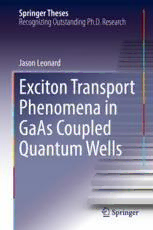
Exciton Transport Phenomena in GaAs Coupled Quantum Wells PDF
Preview Exciton Transport Phenomena in GaAs Coupled Quantum Wells
Springer Theses Recognizing Outstanding Ph.D. Research Jason Leonard Exciton Transport Phenomena in GaAs Coupled Quantum Wells Springer Theses Recognizing Outstanding Ph.D. Research AimsandScope The series “Springer Theses” brings together a selection of the very best Ph.D. theses from around the world and across the physical sciences. Nominated and endorsed by two recognized specialists, each published volume has been selected for its scientific excellence and the high impact of its contents for the pertinent fieldofresearch.Forgreateraccessibilitytonon-specialists,thepublishedversions includeanextendedintroduction,aswellasaforewordbythestudent’ssupervisor explainingthespecialrelevanceoftheworkforthefield.Asawhole,theserieswill provideavaluableresourcebothfornewcomerstotheresearchfieldsdescribed,and for other scientists seeking detailed background information on special questions. Finally,itprovidesanaccrediteddocumentationofthevaluablecontributionsmade bytoday’syoungergenerationofscientists. Theses are accepted into the series by invited nomination only andmustfulfillallofthefollowingcriteria (cid:129) TheymustbewritteningoodEnglish. (cid:129) ThetopicshouldfallwithintheconfinesofChemistry,Physics,EarthSciences, EngineeringandrelatedinterdisciplinaryfieldssuchasMaterials,Nanoscience, ChemicalEngineering,ComplexSystemsandBiophysics. (cid:129) Theworkreportedinthethesismustrepresentasignificantscientificadvance. (cid:129) Ifthethesisincludespreviouslypublishedmaterial,permissiontoreproducethis mustbegainedfromtherespectivecopyrightholder. (cid:129) They must have been examined and passed during the 12 months prior to nomination. (cid:129) Eachthesisshouldincludeaforewordbythesupervisoroutliningthesignificance ofitscontent. (cid:129) The theses should have a clearly defined structure including an introduction accessibletoscientistsnotexpertinthatparticularfield. Moreinformationaboutthisseriesathttp://www.springer.com/series/8790 Jason Leonard Exciton Transport Phenomena in GaAs Coupled Quantum Wells Doctoral Thesis accepted by University of California, San Diego La Jolla, California, USA 123 JasonLeonard UniversityofCalifornia,SanDiego LaJolla,CA,USA ISSN2190-5053 ISSN2190-5061 (electronic) SpringerTheses ISBN978-3-319-69732-1 ISBN978-3-319-69733-8 (eBook) https://doi.org/10.1007/978-3-319-69733-8 LibraryofCongressControlNumber:2017956710 ©SpringerInternationalPublishingAG2018 Thisworkissubjecttocopyright.AllrightsarereservedbythePublisher,whetherthewholeorpartof thematerialisconcerned,specificallytherightsoftranslation,reprinting,reuseofillustrations,recitation, broadcasting,reproductiononmicrofilmsorinanyotherphysicalway,andtransmissionorinformation storageandretrieval,electronicadaptation,computersoftware,orbysimilarordissimilarmethodology nowknownorhereafterdeveloped. Theuseofgeneraldescriptivenames,registerednames,trademarks,servicemarks,etc.inthispublication doesnotimply,evenintheabsenceofaspecificstatement,thatsuchnamesareexemptfromtherelevant protectivelawsandregulationsandthereforefreeforgeneraluse. Thepublisher,theauthorsandtheeditorsaresafetoassumethattheadviceandinformationinthisbook arebelievedtobetrueandaccurateatthedateofpublication.Neitherthepublishernortheauthorsor theeditorsgiveawarranty,expressorimplied,withrespecttothematerialcontainedhereinorforany errorsoromissionsthatmayhavebeenmade.Thepublisherremainsneutralwithregardtojurisdictional claimsinpublishedmapsandinstitutionalaffiliations. Printedonacid-freepaper ThisSpringerimprintispublishedbySpringerNature TheregisteredcompanyisSpringerInternationalPublishingAG Theregisteredcompanyaddressis:Gewerbestrasse11,6330Cham,Switzerland Supervisor’s Foreword The thesis of Jason Leonard addresses indirect excitons (IXs). These specially designed quasiparticles give the opportunity to study fundamental properties of quantum degenerate Bose gases in semiconductors and to develop optoelectronic deviceswhereexcitonsareusedinplaceofelectrons. An IX is a bound pair of an electron and a hole confined in separate layers in a semiconductor structure. The spatial separation between the electron and hole layers allows one to control the overlap of electron and hole wave functions and engineer structures with long IX lifetime, orders of magnitude longer than the lifetime of regular direct excitons. The long lifetimes allow IXs to cool below the temperature of quantum degeneracy. This gives the opportunity to study low- temperature states in cold excitons—cold bosons in semiconductor materials. The findings in cold IXs include a spontaneous transition into a spatially modulated excitonstate,spontaneouscoherenceandcondensationofexcitons,long-rangespin currents and spin textures, and other transport and optical phenomena. Some of theobservedphenomena,likespontaneouscoherenceandcondensationofexcitons, were theoretically predicted and some of them, like spontaneous transition into a spatiallymodulatedexcitonstate,werefoundexperimentallyinacoldIXgas. The long IX lifetimes also allow IXs to travel over large distances before recombination. This provides the opportunity to study exciton transport and spin transport by optical imaging. A set of exciton transport phenomena has been observed,includingtheinnerringinexcitonemissionpatterns,excitonlocalization- delocalization transition in random potentials, lattices, and moving potentials, coherent exciton transport with suppressed scattering, and spin transport and spin textures. The energy of IXs can be controlled by applied electric field. This gives the opportunitytocreatein-planepotentiallandscapesforIXsbyvoltage.Advantages ofelectrostaticallycreatedpotentiallandscapesincludetheopportunitytorealizea desiredin-planepotentialprofileandcontrolitbyvoltageinsitu,i.e.onatimescale shorter than the IX lifetime. IXs were studied in a variety of electrostatic traps, inperiodicpotentialsincludingstaticandmovingelectrostaticlattices,ramps,and narrowchannels. v vi Supervisor’sForeword Besidesformingaplatformforstudyingbasicphysicsofbosonsinsemiconduc- tors,excitonscanalsobeexploredforthedevelopmentofsignalprocessingbased oncomputationalstatevariablesbeyondmagnetismandcharge.Excitonicdevices are potentially well suited to the development of an alternative to electronics due totheopportunitytorealizeenergy-efficientcomputationwithefficientcouplingto opticalcommunication.ThepossibilitytocontrolofIXenergy,fluxes,andemission ratebyvoltage,light,andIXinteractionmakesIXssuitableforthedevelopmentof excitonicsignalprocessingdevices. ThethesisofJasonpresentsboththestudiesoffundamentalexcitonphenomena and the development of excitonic devices. In particular, the thesis describes the observation of IX spin transport, the observation of the dynamical localization- delocalization transition for excitons, the development of excitonic ramp, the development of excitonic conveyer, and the development of optically controlled excitonic transistor. The results are of interest to students and scientists working inoptics,condensedmatterphysics,andphysicsofcoldgases. UniversityofCalifornia,SanDiego LeonidButov September,2017 Acknowledgements I would like to thank my advisor Leonid Butov. Without his support and encour- agement this work would not have been possible. I would also like to thank him for teaching me to think simply without sacrificing rigor and improving my communicationskills. I’dliketothankSenYangfortrainingmeinlab;heisremarkablypatient.I’dlike tothankAaronHammackforthemanyphysicsdiscussionswehad.I’dliketothank AlexHighforworkingwithmeoninterferencemeasurementsandhelpingmelearn to think though problems. I’d like to thank Alex Winbow for giving me a greater appreciation for experimental equipment. I’d like to thank Yuliya Kuznetsova and Mikas Remeika for the help they gave me on many experiments. I’d also like to thankYuliyaforreadingthedraftofmydissertationandgivingmehelpfulfeedback. I’d like to thank Denis Scalbert, Masha Vladimirova, Steeve Cronenberger, MarionRiche,andSergueïAndreevforhelpingmefeelathomewhenIspenttimein France.I’dliketothankMashaforthemanyphysicsandprogrammingdiscussions we had. I’d like to thank Denis and Steeve for teaching me about time resolved reflectionandKerrrotationmeasurements. I’d like to thank Peristera Andreakou for being a good friend and the many lab discussionswehad. I’d like to thank my parents for the constant support and encouragement they provided. vii Contents 1 Introduction ................................................................... 1 1.1 SemiconductorIntroduction............................................ 2 1.1.1 BulkGaAs...................................................... 2 1.1.2 SingleQuantumWell .......................................... 3 1.1.3 CoupledQuantumWells....................................... 4 1.2 TransportPhysics....................................................... 6 1.3 SpinPhysics............................................................. 6 1.3.1 D’yakanovandPerel’SpinRelaxation........................ 8 1.3.2 DresselhausInteraction ........................................ 8 1.3.3 Electron–HoleExchangeInteraction.......................... 9 1.4 ExperimentalMethods ................................................. 9 1.5 DissertationOverview.................................................. 10 References...................................................................... 10 2 ControlledExcitonTransportviaaRamp................................. 15 2.1 Introduction............................................................. 15 2.2 RampDesign............................................................ 15 2.3 ExperimentalMethods ................................................. 16 2.4 QualitativeResults...................................................... 16 2.5 QuantitativeResults .................................................... 19 2.6 TheoreticalModel ...................................................... 21 2.7 Summary................................................................ 22 2.8 FurtherReading......................................................... 22 References...................................................................... 22 3 Controlled Exciton Transport via an Optically Controlled ExcitonTransistor ............................................................ 23 3.1 Introduction............................................................. 23 3.2 Realization.............................................................. 23 3.3 ExperimentalMethods ................................................. 24 3.4 Results................................................................... 25 3.5 Versatility ............................................................... 27 ix x Contents 3.6 TheoreticalModel ...................................................... 27 3.7 Summary................................................................ 30 3.8 FurtherReading......................................................... 30 References...................................................................... 30 4 ControlledExcitonTransportviaaConveyer............................. 33 4.1 Introduction............................................................. 33 4.2 ExperimentalMethods ................................................. 33 4.2.1 CircuitSchematicoftheConveyerRFSystem ............... 35 4.3 QualitativeResults...................................................... 36 4.4 QuantitativeAnalysis................................................... 36 4.4.1 CalibrationoftheConveyerAmplitude....................... 36 4.4.2 QuantitativeResults............................................ 38 4.5 TheoreticalModel ...................................................... 40 4.5.1 ConveyerAmplitudeDependence............................. 41 4.5.2 ConveyerVelocityDependence................................ 42 4.5.3 DensityDependence ........................................... 42 4.6 Summary................................................................ 43 4.7 FurtherReading......................................................... 43 References...................................................................... 44 5 ObservationofExcitonSpinTransport .................................... 47 5.1 Introduction............................................................. 47 5.2 ExcitonSpinDynamicsWithoutTransport ........................... 48 5.3 DirecttoIndirectExcitonConversion................................. 49 5.4 PhenomenologicalModelforExcitonSpinTransport................ 49 5.5 ExperimentalMethodsandData....................................... 51 5.6 TemperatureDependence .............................................. 52 5.7 DensityDependence.................................................... 53 5.8 SpatialDependence:ExcitonSpinTransport ......................... 53 5.9 Discussion............................................................... 56 5.10 Summary................................................................ 57 5.11 FurtherReading......................................................... 57 References...................................................................... 58
